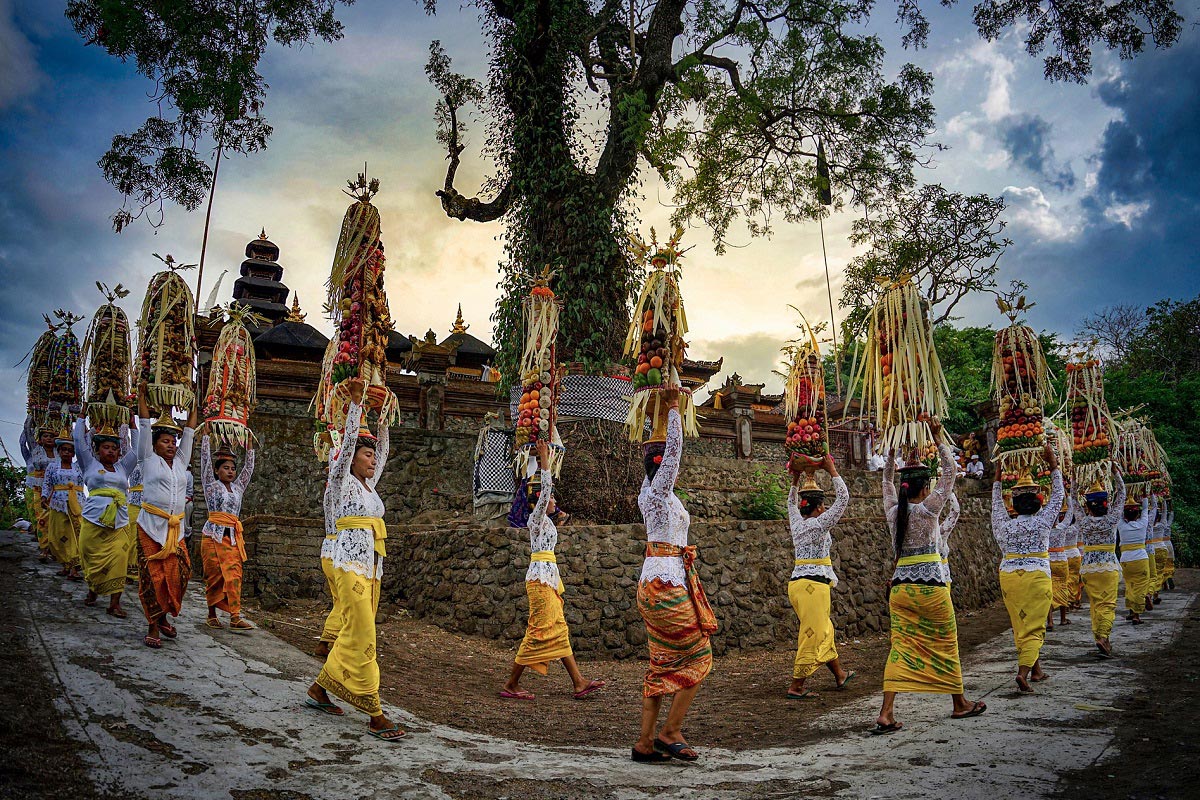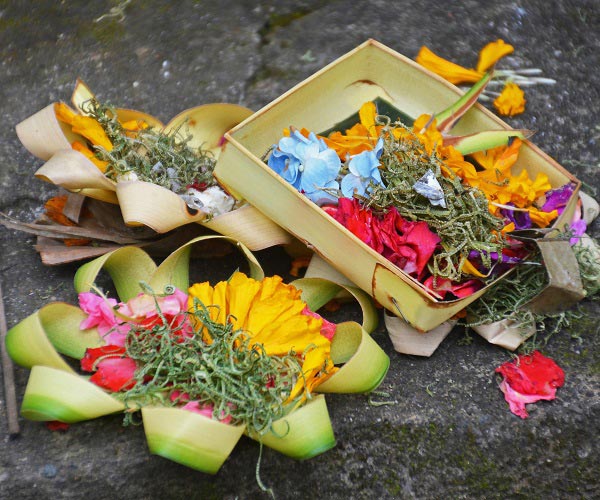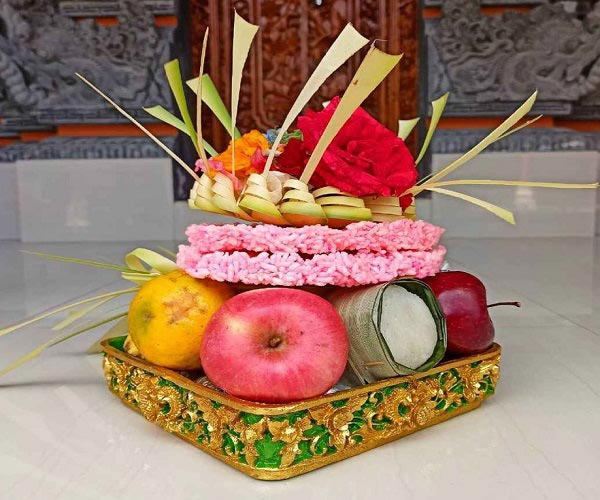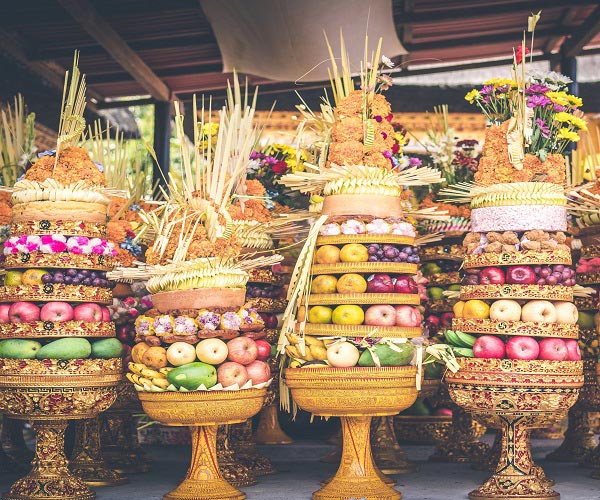
Balinese Hindu Offering is a ritual offering process carried out according to Hindu religious beliefs on the island of Bali. As you know that Hindus in Bali came from Hindus in India, but in practice the Hindus in Bali adapted to local customs before the arrival of Hinduism, so you can see many differences in the process of religious ceremonies found in Balinese Hindus with Hindus in India. One of them is the process of offering to the God Almighty which is manifested by various kinds of offerings according to the customs and traditions of the people, in general, offerings that are made every day such as Segehan and Canang Sari which we often encounter on the street, in front of houses or in front of shops. It is a form of offering as a form of gratitude to God for his blessings so far that has given life, safety, health and prosperity. A procession presents offerings to God Almighty as a form of gratitude for the gift that has given life and salvation.
All You Need To Know About Balinese Hindu Offering
What is Balinese Hindu Offering
Balinese Hindu Offering is a form of respect or gratitude to Ida Sang Hyang Widi Wasa as God Almighty who has given life, safety, health and others, which is symbolized by Banten (Sesajen), while this offering consists of many kinds, so the use of the name Banten covers a very wide range. The banten that is often offered every day is called Banten Segehan or Banten Canang Sari. Balinese Hindu Offering there are various forms and facilities used depending on the purpose of the offering and the request of the ceremony being held. On a daily basis, we usually make Canang Sari offerings, which are offerings made of coconut leaves which are shaped into squares, triangles or rounds and filled with flowers of various colors such as red, white and yellow, which symbolizes the Tridharma of Hindu Bali, namely Lord Brahma, Lord Vishnu and Lord Shiva. The flowers contained in this canang sari are a form of sincerity and purity, besides that there is also potpourri, namely pandan leaves with color Green which are sliced into small pieces and placed in the canang sari which emit a fragrant aroma which is a symbol of wisdom. In addition, the canang sari is also filled with sliced sugar cane, bananas, and small Balinese snacks and some are filled with sweets. So when you come to Bali you will see that in front of the house or shop there is a canang sari placed in front which is a symbol of gratitude to God Almighty.
Banten is Balinese Hindu Offerings
Banten is one of the offerings made by Hindus by offering fruits and flowers and also in the form of animals such as pigs, chickens, geese and others. Banten Contains a very symbolic meaning and a high philosophy and combines with fine arts and make-up in making the form of the offering which is an expression of the people's gratitude to the creator. With the art factor in the making of offerings, it will lead the mind towards inner beauty towards inner peace and self-satisfaction. This peace of mind is very important in achieving concentration of thought in praying before God Almighty, therefore the art factor plays a very important role in moving towards a positive religion as a supporting element for the implementation of the ceremony. Banten has various forms of art and appreciation in making offerings and consists of three very important elements, the three elements are:
- Mataya: It is one of the offerings whose materials consist of plants and plants such as leaves, flowers and fruit. This form of offering is most often encountered in everyday life such as on the street, in front of people's houses, local people's temples and in front of shops, where it is appreciated in the form of canang sari offerings, segehan and sodaan offerings.
- Maharya: Is one of the offerings derived from animals such as pigs, goats, buffalo and cows. The use of animals is one of the complementary means carried out in a very important ceremony, and this we encounter when there are important events such as mecaru, ngusaba and other Hindu religious practices.
- Mantiga: Is one of the offerings that comes from animals born from the egg itself such as chickens, ducks, geese, chicken eggs and others. The use of this bird is also a complementary means in holding one of the major religious ceremonies, which we often encounter when there is a piodalan ceremony at the local temple, Galungan and Kuningan holidays and other holidays.
Type Daily Balinese Hindu Offerings
As for the Hindu religion in Bali, in making offerings there are several kinds of offerings depending on the purpose of the offerings and also depending on the customs and culture where the offerings take place. In addition, the form of offering is also inseparable from the profession that is occupied by the local community, such as farmers who make offerings to Dewi Sri Sedana who is the Goddess of Fertility by offering agricultural products such as rice and fruites, while it is different from the profession as traders who make offerings in the form of canang sari with fruits to invoke the blessing of the Goddess of Rambut Sedana who is the God of Prosperity. Here you can see the form of the offering depending on the purpose of the offering. As for if the daily offerings are carried out the same, namely by making Canang Sari offerings. There are several offerings Banten made every day by Hindus in Bali to ask for safety, health and prosperity in living life.
- Segehan: Segehan is an offering that is offered to bhutakala so as not to disturb and not confuse our minds with evil incitement from evil spirits. With this segehan is expected to neutralize and eliminate these negative influences. Segehan can also be said to be a symbol of the harmonious relationship between humans and all of God's creations, including those that we cannot see. Segehan is usually served every day. Usually we can see this segehan on the road in front of the shop or in front of the house. This segehan is also based on the level and day of the ceremony, if on normal days it usually only serves Segehan Kepel Putih, namely leaves filled with a pinch of rice and placed in front of the yard or shop, on special days such as the full moon then the rice will be colored white, yellow, red and brumbun (mixed colors) is called segehan manca color.
- Canang Sari: Is an offering that is made every day to Ida Sang Hyang Widhi Wasa who as the creator of humans, as a form of gratitude for having been given life, safety, prosperity, happiness, this gratitude is symbolized by presenting a canang sari in the form of a flower placed in Coconut leaves are shaped in a square, triangular or round shape, you may often see this canang sari in front of houses, streets, temples, shop fronts and others. This is a sacred offering made to God who is the creator of man. Canang comes from the word "Can" which means beautiful, while "Nang" means purpose or intent (in Kawi / Old Javanese language), Sari means core or source. Thus Canang Sari means to invoke Widya's strength before Sang Hyang Widhi and His Prabhawa (manifestation) both on a world realm and subtle spirit realm.
- Pejati: Is an offering that is carried out on a special day or there is a religious ceremony that requires the offering of Pejati. The Pejati are a group of offerings that are very complete and consist of canang sari, fruit, diamonds and others. Where Pejati is a complete offering that is presented to Ida Sang Hyang Widhi Wasa to express a sense of sincerity to carry out a ceremony and ask to be witnessed for the purpose of salvation, Pejati's offering is the main offering that is always used in religious ceremonies. This Pejati is only carried out on special days or special days, and is not held every day, only in religious ceremonies requires this Pejati because it is a complete offering to be presented before God Almighty.

Canang Sari

Banten Sodaan

Banten Gebogan
Offerings on the Great Ceremony
As for the offerings made on great ceremony, it is very different from the offerings made every day, the difference in the completeness of the offerings made, because on big days it is believed that gods come down to the world and reside in temples where there are ceremonies, and on the day of the ceremony we make complete offerings. as a form of gratitude to God for having been given life, prosperity and health. Therefore, if it is a big holiday like Galungan and Kuningan you will see many Hindus going to the temple to pray and some you will see bringing offerings that may be different from the offerings you see every day. The major offerings offered are as follows
- Banten Sodaan: Is a complete offering in the form of a holy daksina containing fruits and canang sari which is addressed to the ancestors and usually this sodaan is placed in every temple in the house, if at home there are many temples then need lot to make sodaan and put in each temple. If you are in Bali on a big holiday you can see this soda offering at every temple in Bali. This Sodaan is offered only on major ceremonial days such as Galungan, Kuningan and Pagerwesi as well as other big days. In addition, soda is also offered when praying at large temples such as Besakih, Lempuyang, Tanah Lot, Uluwatu and other large temples.
- Banten Gebogan: It is an offering that we may see on the day of a large religious ceremony in the form of fruits placed in a container that upholds the dignity, while the height of this gebogan varies from 50 cm to 100 cm high, this depends on taste from that said, there is no necessity in the height of this gebogan. If you are in Bali during the big holidays you can see women carrying gebogan on their heads to go to the temple, a very beautiful sight. Gebogan is usually offered when there is a religious ceremony at the temple, and usually on holidays such as Galungan and Kuningan and other religious days that are part of the big Hindu holidays in Bali
- Babi Guling: More known with name Suckling Pig is an offering in the form of offerings or ceremonial means which is a symbol of fertility and prosperity, and often when a large religious ceremony will require babi guling as one of the complementary means of the ceremony, so babi guling plays a very high role in the course of certain ceremonies. The use of the offering babi guling is based on the level of the ceremony, sometimes there are religious ceremonies that do not require the babi guling and can choose other alternative as offering such as grilled chicken or eggs.
The Purpose of Balinese Hindu Offerings
The purpose of this offering is also very useful for the life around us. In a Hindu ceremony on the island of Bali using offerings in the form of fruit and flowers and these offerings are known as Banten and Canang. If you vacation on the island of Bali and walk around the city you will often see offerings in front of shops, in front of houses, small shrines in front of houses, these are offerings by Hindus in Bali, and the types of offerings have different functions according to the purpose of the offerings. The positive goals of making offerings that are also very beneficial for the local community and the environment are as follows
- For God: The teachings of Hindus in Bali teach that one of worshiping God is to give offerings in the form of fruits and flowers, this is stated in the sacred Bhagavadgita, Chapter IX, verse 26 which says that "Anyone who with obeisance offers to Me leaves, flowers, fruits or water, offerings based on love and coming from the bottom of a pure heart, I accept."
- For yourself: offerings can also be for yourself where one of the religious rituals is to achieve inner satisfaction, when humans have ideals they will dedicate themselves to divinity by showing love and devotion to God, so by doing this worship and offerings as a form of self-satisfaction and will make your day full of happines in this life
- For the General Public: The ingredients for the offering consist of fruit and flowers, so this offering makes agricultural and plantation products more developed because fruit and flower materials are needed as one of the means in making offerings that make agricultural products sell well and also prosper people
- For the Environment: The ingredients from banten and canang are very helpful for farmers and plantation owners who indirectly also keep the land fertile and preserved, thus forming the life of insects that eat fruit and flower juices to help more photosynthesis occur which converts carbon dioxide become oxygen
Banten is a Symbol of Harmonyings
Banten or Offerings are a form of offering that symbolizes the gratitude of Hindus to Ida Sang Hyang Widhi Wasa as God Almighty and his manifestations for giving life, grace and all protection to this universe, so that harmony and balance in nature are maintained. In addition, offerings can also balance the universe, which is meant here is the natural world with the unseen realm inhabited by bhuta kala (spirits) so as not to interfere with life in the natural world. Because this world is created from the philosophy of cause and effect, which can be described as formed from good and bad, black and white as a form of balance. The offerings are to balance this cause and effect philosophy so that we live a very harmonious life. A Balinese Hindu offering procession that is very interesting to see and the procession of offerings like this only exists on the island of Bali, which is mostly inhabited by the majority of the population who are Hindus.
